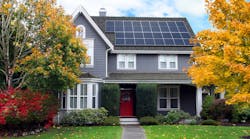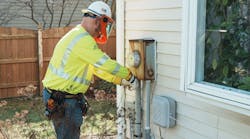From coast-to-coast this past summer, Americans suffered from record breaking heat waves that, in some parts of the country, stretched for weeks on end. In order to make these temperatures manageable, let alone survivable, most were running their air conditioners nearly nonstop. Not only does this lead to large electric bills, it also strains our entire grid, which can lead to life threatening blackouts. Thankfully, as we have seen, customer-sited resources like home solar paired with batteries can help create a more resilient and hardened grid and help avoid blackouts for everyone.
In spite of its tremendous advantages, only 4% of America’s 75 million single family homes have rooftop solar and even fewer have batteries. We have our work cut out for us to get these solutions installed quickly and efficiently for families wanting to electrify their home and manage increasing bills.
But how do we quickly bring these critical clean energy solutions to an aging housing stock? According to a recent survey, the average age of an American home is 40 years. Most American homes were built when the demand for electric service rarely exceeded 100 amps. According to energy research firm Pecan Street, service panel upgrades are frequently required to support the additional energy demand of new electric products like solar panels, EVs, heat pumps and other smart appliances. These are costly and collectively represent a $100 billion barrier to residential electrification.
Fortunately, we have solutions to this $100 billion problem. ConnectDER's meter adapter platform helps bridge this gap, especially for underserved low- and moderate-income populations that more frequently live in older homes, which were never intended to generate power on site.
Here’s how it works: when solar and batteries are installed, contractors and utilities must ensure that a home’s electrical panel can comply with the National Electric Code to handle the increase in power created by the electricity being generated and new electrified loads used at the home. Sometimes utilities require an electrical investment called a meter service upgrade which can cost anywhere between $2,000 to $25,000 depending on the utility, and takes weeks or months to complete. It’s no wonder that this process can slow down the pace of installing solar and batteries and locks many low income people out of being a part of the clean energy transition.
ConnectDER’s hardware and software for many customers can eliminate the need for a main panel upgrade altogether. Known as a meter socket adapter (MSA), this technology is easily attached in between the meter display and the meter box. The meter MSA helps manage the increased load or generation and ensures that existing systems can be utilized without having to make those costly upgrades. A meter socket adapter can be installed by a trained, certified contractor, eliminating the need for multiple trips to homes, reducing time and costs. Home solar installers like Sunrun employ solutions like meter collars.They only take minutes to install at lower cost and can eliminate the delays to schedule the upgrade in alternative, while also reducing burden on utilities and their workers.
Solar and meter adapters are an effective pair and are already in use by utilities in Colorado, Arizona, Oregon, Northern California, and more. New Jersey recently approved a law that mandates the use of meter collars across the state. They haven’t been adopted everywhere, however, and this has prevented families and small businesses from benefiting from clean and cost-efficient clean energy solutions that are key for our electrified future.
In addition to helping with rooftop solar and batteries, meter adapters will soon also be able to pair with electric vehicle chargers at people’s homes. This may eliminate similarly expensive installations and upgrades, since EVs can double the electricity need from a home. Electric vehicles are becoming increasingly common, recently accounting for one- quarter of all cars sold in California. Not only will these new meter collars help even more people electrify their lives, they can help provide desperately needed load reduction to the distributed grid to reduce risk of grid-wide blackouts, when properly enabled.
As more and more people across the country become interested in installing solar and batteries to protect their homes from blackouts or keep their bills down when they’re forced to run their air conditioning all day and all night, it’s imperative that we modernize how we connect local solar and batteries to a home at the meter.
Steven Rymsha is the director of Public Policy at the national rooftop solar and battery company, Sunrun. Jonathan Knauer is the VP Policy and Market Strategy of ConnectedDER, a meter collar company based in Philadelphia, PA.


